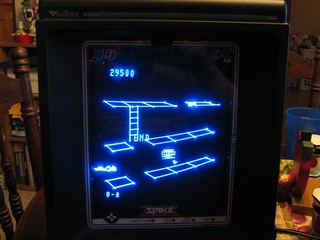Why does a game from 2002 look so much better than one from 1996? Well, a big part of that is what the computers at the time were able to do. Games today have crazy high polycounts (that's how many polygons) compared to games from even just 5 years ago.
So, where do the polygons begin? Is it with the Vectrex? That thing did have some rockin' vector graphics.
The Vectrex's rockin' vector graphics in action
Others contest that is was 1992's survival horror game, "Alone in The Dark" for DOS and later the 3DO.
Alone in the dark was ambitious. It had fully animated 3D models for characters, enemies, items, all sorts of things.
So, part of what made Alone in The Dark possible, was the use of pre-rendered backgrounds. This means that the background does not move with the game, but rather is a still image or series of images. This allowed for vibrant, 3D looking backgrounds.
Pre-rendered backgrounds were most common in DOS/PC, Playstation and various Saturn games of the 90s and early 2000s.
Pre-rendered backgrounds are still used today, often in indie games. Scott Cawthon (Who I've mentioned before) uses them in all of his games.
Today, the use of a pre-rendered background may be a stylistic choice as opposed to a limitations one. It's a clever way to get more polygon bang for your buck that today is seen as iconic of those games of old. To close, here's some awesome examples of pre-rendered backgrounds old and new.
Super Mario RPG 1996
Five Nights at Freddy's 2 2014
Darkseed 2 1995

No comments :
Post a Comment